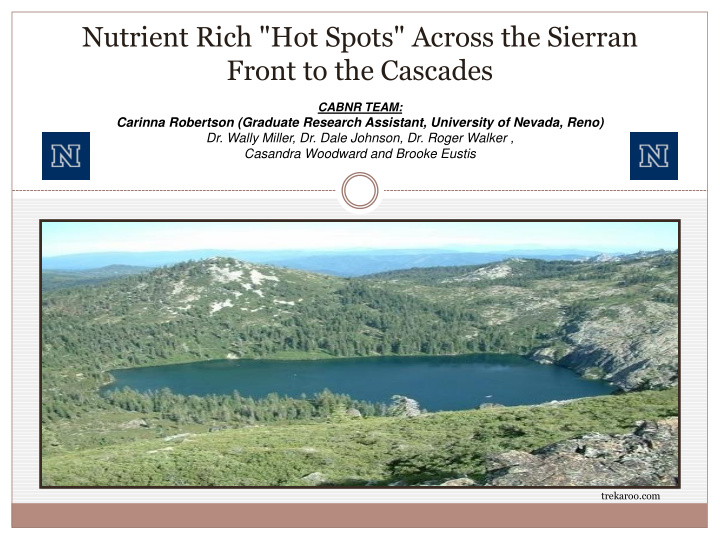



Nutrient Rich "Hot Spots" Across the Sierran Front to the Cascades CABNR TEAM: Carinna Robertson (Graduate Research Assistant, University of Nevada, Reno) Dr. Wally Miller, Dr. Dale Johnson, Dr. Roger Walker , Casandra Woodward and Brooke Eustis trekaroo.com
Nutrient Rich "Hot Spots" Across the Sierran Front to the Cascades Introduction Biogeochemical “hot spots” or “hot moments” Transport of Nutrients (Nitrogen (N) and Phosphorus (P) Calcium (Ca 2+ ), Magnesium (Mg 2+ ), Potassium (K + ) Past /Current Research Biologically available N and P traveling from the O horizon along preferential flow paths (Miller et al., 2005) Identified the periodic presence of nutrient rich “hot spots/moments” within the soil matrix; albeit the spatio-temporal scale was uncertain (Johnson et al., 2011).
Nutrient Rich "Hot Spots" Across the Sierran Front to the Cascades Goal of this Research To develop a better understanding of water flow and nutrient infiltration patterns across the Sierra Nevada Mountain Range. Potential Cause of Excess Nutrients Management Strategies Primary Objectives Biogeochemical “Hot Spots” Presence or absence Chemical composition Geographic distribution
Nutrient Rich "Hot Spots" Across the Sierran Front to the Cascades Project Design - 5 Study Locations: Castle Lake, CA Sagehen, CA Truckee, CA Little Valley, NV Kings River, CA
Project Design: Controlled Grid Analysis Lysimeter /Capsule Grid Controlled Grid Plots 16 15 14 13 2-9m 2 , 16 points Resin Lysimeters 12 10 11 9 Resin Capsules 2 Settings: Uphill Upland Forested Ecotone Capsule 8 7 6 5 or Lysimeter Transition/Variable Point Down-Gradient Ecotone 4 3 2 1 3 meters Runoff Collector Runoff Collector
1 st and 2 nd Year Capsule Results Moderate and Extreme Outliers ~ 9 m 2 Most Nutrients Would Correlate at a Grid Point Nutrient "Hot Spot" Detection at TR Nutrient "Hot Spot" Detection at the TR Site 2nd Yr. (umol/cm2) Site 1st Yr. (umol/cm2) 20 20 16 Vertical Grid Positions 16 Vertical Grid Positions Ca Ca Mg Mg 12 12 Ortho-P Ortho-P NH4-N NH4-N 8 8 NO3-N NO3-N 4 4 0 0 0 4 8 12 16 20 0 4 8 12 16 20 Horizontal Grid Positions Horizontal Grid Positions
Capsule Grid Results Moderate and Extreme Outliers ~ 256 Grid Points only 4 Points Detected Similar High Nutrient Fluxes (1.5%) Nutrient" Hot Spot" Detection at Nutrient "Hot Spot" Detection at the the LVJP Site 2nd Yr. (umol/cm2) LVJP Site 1st Yr. (umol/cm2) 20 20 16 16 Vertical Grid Positions Vertical Grid Positions Ca Ca 12 Mg 12 Mg NH4-N Ortho-P NO3-N NH4-N 8 8 Ortho-P NO3-N 4 4 0 0 0 4 8 12 16 20 0 4 8 12 16 20 Horizontal Grid Positions Horizontal Grid Positions
Capsule Grid Results Moderate and Extreme Outliers Nutrient "Hot Spot" Detection at the Nutrient "Hot Spot" Detection at the SL Site 1st Yr. (umol/cm2) SL Site 2nd Yr. (umol/cm2) 20 20 16 16 Vertical Grid Positions Vertical Grid Positions Ca Ca 12 12 Mg Mg Ortho-P Ortho-P 8 NO3-N 8 NH4-N NH4-N NO3-N 4 4 0 0 0 4 8 12 16 20 0 4 8 12 16 20 Horizontal Grid Positions Horizontal Grid positions
Capsule Grid Results Moderate and Extreme Outliers Nutrient" Hot spot" Detection at CL Nutrient "Hot Spot" Detection at CL Site 2nd Yr. (umol/cm2) Site 1st yr. (umol/cm2) 20 20 Vertical Grid Position Vertical Grid Positions 16 16 Ca Ca NO3-N Mg 12 12 Mg NO3-N NH4-N NH4-N 8 8 Ortho-P Ortho-P 4 4 0 0 0 4 8 12 16 20 0 4 8 12 16 20 Horizontal Grid Position Horizontal Grid Positions
Truckee Capsule Grids NH4-N (umol/cm 2 ) Fall Collection 2009 0m 1m 2m 3m Conc. NH 4 -N (ug/cm 2 ) 0m 1m 2m 3m NH4-N (umol/cm 2 ) Spring Collection 2010 0m 1m 2m 3m Fall , NH4-N Spring, NH4-N (umol/cm 2 ) (umol/cm 2 ) 0m 1m 2m 3m
Capsule Grid Fall Analysis Sagehen Upland Site Moderate and Extreme Outlier Sagehen Upland Site 25 20 ug/cm2 15 10 5 0 1 3 5 7 9 11 13 15 17 19 21 23 25 27 29 31 1st Yr. NO3-N ug/cm2 2nd Yr. NO3-N ug/cm2
Nutrient Trends Across Sites ortho-P umol/cm 2 . 1 st Yr. 2 nd Yr.
NO 3 -N umol/cm 2 NH 4 -N umol/cm 2 . 1 st Yr. 2 nd Yr.
Ca 2+ umol/cm 2 Mg 2+ umol/cm 2 . 1 st Yr. 2 nd Yr.
Conclusions Biogeochemical “Hot Spots/Moments” are Variable Spatial Variation Seasonal and Annual Variation 9 m 2 all Nutrients will Possibly Correlate at a Single Grid Water Flow and Nutrient Infiltration Patterns were Extremely Variable Geographic Distribution
Questions http:www.sierranevadaphoto123rf.com
Recommend
More recommend